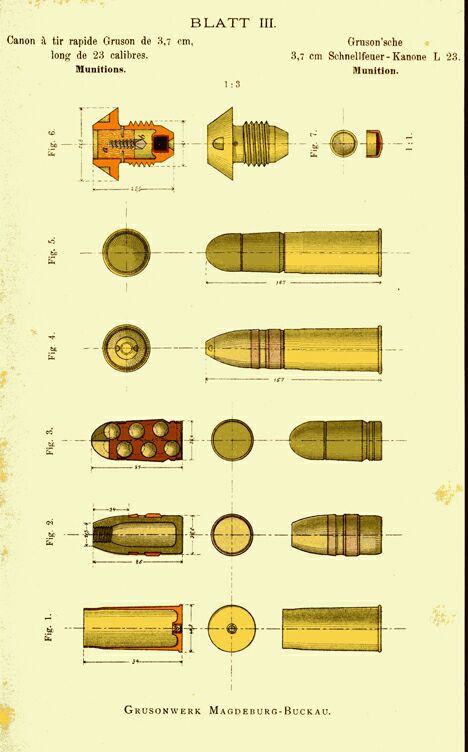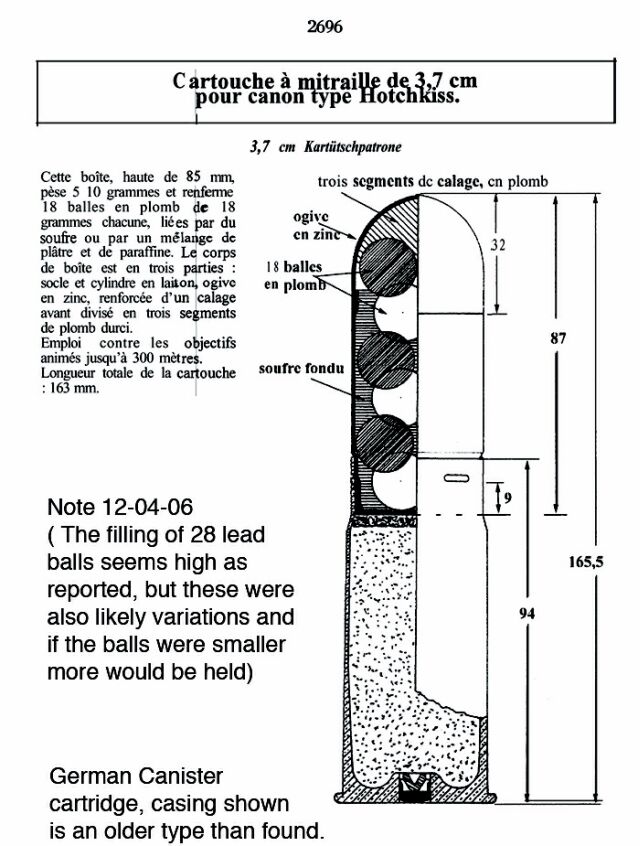

 The South African
The South African
In February 1973 the remains of a shell together with cartridge case were brought in to the McGregor Museum in Kimberley. They had been found approximately 15-20 cm. below the ground surface by the donor, Mr Cornellissen, while digging house foundations on the north-west side of Kimberley.
The cartridge case appears to be that of a ‘pom-pom’ (37mm Qf Maxim-Nordenfeldt) and is base-stamped PATR FABR KARLSRUHE. This is comparable to other pom-pom rounds as used by the Boer forces during the Anglo Boer War of 1899-1902 (e.g. Museum specimen stamped PATRONEN FABRIK XII 97 KARLSRUHE). The round had not been fired, but the major portion of the shell is missing. Some of the shell wall was broken away by Mr Cornellissen’s labourers, who found a piece of newspaper, ‘very old’, jammed in the shell casing. The newspaper wad was thrown away, so unfortunately no clue as to its date was forthcoming. Inside what remained of the body of the shell were found, not the hoped for diamonds, but 28 shrapnel bullets (total weight 308,6 grammes; individual weights varying between 10,4-11,8 grammes; average diameter 12mm).
At the outbreak of the Anglo Boer War the Staats Artillerie of the Transvaal Republic had 25 ‘pom-poms’ (Breytenbach ‘Geskiedenis van die Tweede Vryheidsoorlog 1899-1902’ vol. I other estimates vary from 21-25), with a number of rounds of ammunition estimated by different sources between 46 311 and 72 000. At least 5 of these weapons were operating in the Magersfontein area, south of Kimberley, and one was amongst the guns captured by the British from Cronjé’s laager at Paardeberg. The British troops disliked the rapid fire of the pom-pom (it operated on the machine-gun principle, belt-loaded with 25 shells per belt) and requests for similar weapons resulted in 57 Vickers-Maxim 37mm QF ‘pom-poms’ being sent out (‘The Times History of the War in South Africa’: Headlam ‘The History of the Royal Artillery’ only mentions 50). The first three British pom-poms arrived in South Africa in time for the Paardeberg action.
The standard pom-pom shell was a 1-lb [454gm] cast iron common shell, powder filled, with a thickness of wall of approximately 7mm (.275” in the British manufactured rounds). The shell was fitted with a graze-action nose fuze of percussion type. A pointed steel armour-piercing shell, base-fused, also existed and is reported to have been ‘occasionally employed in the field by the Boers’ (G. H. Makins ‘Surgical Experiences in South Africa 1889-1900’). The British had a similar shell of which it was reported that the base fuse frequently worked loose while travelling and fell out in flight (Royal Artillery Institute Minutes of Proceedings).
To return to the problem shell — what is it? It definitely is not the remains of a common shell; even forgetting the shrapnel bullets, the thinness of wall precludes this. A percussion-fuzed shrapnel shell would nullify the whole purpose and principle of shrapnel shells; while no time-fuze small enough for a pom-pom shell existed, quite apart from the problems inherent in a belt-loaded, time-fuzed round. The British produced common shell, steel shell, practice shell and blank cartridges for their pom-poms, but the relevant descriptions in no way tally with the Museum’s problem round. It is always possible that this was an individual, home-made effort, and was never intended to be fired. Against this solution is the fact that what remains of the shell is well made and fits the cartridge case accurately — it is not simply an instance of someone jamming something inside something else — and why bother to fake a cartridge which never existed? Another possibility exists and is put forward here as a tentative suggestion for the interest of readers, and in the hope that someone can either confirm or refute the idea, or come up with a better alternative.
According to a ‘Report on the Artillery of the South African Republic from 12th October, 1899 to 30th May, 1900’ by M. Casson, [who was in charge of Begbie’s and Wright’s works at the time when they were manufacturing gun ammunition (translated copy at the Royal Artillery Institute, Woolwich)] projectiles for the Krupp and Creusot guns used by the Boers included (1) cast iron common or ring shell (2) shrapnel shell (3) case shot. The last mentioned was a zinc projectile, with wood base, filled with lead balls (12mm diameter for the 75mm field guns, 15mm for the 155mm Creusot ‘Long Tom’ compared with average diameter of 12,7mm (0,5in) of British shrapnel used with 12pr and 15pr guns). Photographs exist which appear to show the case shot, and the Museum possesses a complete round. The report states that the 75mm field guns were initially issued with 2 000 rounds per gun, ‘of which 500 were case shot which were never, or rarely used’, the case shot being ‘almost always abandoned in the retreats’. Case shot were shrapnel-filled and lacked both fuze and bursting charge, being designed to break up either in the bore of the gun, or immediately after discharge. By 1899 it had been rendered virtually obsolete by the increased effectiveness of rifle power, and while the British gun also still carried case shot two rounds on the gun and one or two on the limber — Diamond Hill is the only quoted instance of its use. Should extremely short range fire be required, the effect of case shot could be duplicated by using shrapnel shell with the time fuze set at ‘0’, when the shell would burst within 50 yards of the muzzle. Case shot was, however, produced in South Africa for the Boer guns, and the McGregor Museum’s specimen comprises a zinc projectile, as described in the report, fitted with a Krupp brass cartridge case.
This re-use of cartridge cases was standard practice
amongst the Boer forces, owing to shortage of ammunition.
Artillerymen operating at the front had express orders not
to keep the cases, but to return them to the ‘Gouvernement
Artillerie Werken’ in Johannesburg for cleaning and
re-forming. The work was done and shells manufactured
(according to the report) at several factories — Thomas
Begbie’s foundry (the major source, until the explosion
there on 24th April, 1900); ZASM (The Netherlands
South African Railway Company) which suffered from
having no foundry; the Factory (Village Deep) where
most of the fuzes were made; Messrs Wright, Boag & Co.,
responsible for some of the casting; Delfos Brothers, etc.
Pom-pom cartridge cases were also re-used and the
section of the report dealing with ammunition for the
Maxim-Nordenfeldt reads:
‘The 1.5 inch guns were fired a great deal at the
beginning of the war, so that the great stock at the
Artillery Camp, received at the commencement of 1899,
was soon exhausted. In February, the “Gouvernement
Artillerie Werken” received an order to make this
ammunition. On account of the enormous difficulties
experienced, they were not able to make the first
projectiles till the end of March. During the month of April,
they made about 2 500, of which one third was lost in
the explosion. Afterwards, they supplied the Transvaal
Government with about 3 500, of which about 1 500 were
at the Powder Factory on 27th May and were sent back
to Pretoria with a great quantity (about 5 000) of
re-formed and re-capped cases; of these 1 500 hardly one
quarter was completed; the remainder were not loaded
or fixed in the cases.
‘At the Begbie factory, they left some thousands of projectiles in the yard whose casting had been stopped a fortnight before the closing of the works. The casting was done by the firm of Wright, Boag & Co. . .
Putting together the existence of ‘home-made’ case shot, the Boer re-use of cartridge cases, and the nature of the problem round, it would seem that this could have been an experimental pom-pom case shot. Close examination of the projectile shows an apparent ‘seam’ or fold of metal down one side of the body of the shell, similar to that on the zinc projectile of the 75mm case shot. A metal analysis might be informative, but so far has not been done. How such a round — whatever it may be — came to be buried at Kimberley and what happened to the rest of the projectile can only be surmised.
If one accepts that it is case shot, the obvious next question is why no other specimens have apparently been recorded. Were field trials ever carried out, and was pom-pom case shot found unsatisfactory in principle or in practice? Did the Boers find that no need existed for such a shortrange projectile operating effectively as a giant automatic shotgun, or was it manufacturing problems, or the British capture of Johannesburg and Pretoria which killed the project at its prototype stage? If, on the other hand, it is not a pom-pom case shot, one has the even less likely explanation of an experimental pom-pom shrapnel shell fitted with the standard percussion fuze. If neither of these what is it?
The following e-mail and diagrams arrived in December 2006 from
Gordon Spragge
gspragge@hotmail.com
The 37mm cartridge that was found was a German made cannister shot, I attach an image from an older German manufacturer, the projectile as found was likely reloaded into a more modern casing as this image dates late 1880s. I can supply another image if you require one. German canister rounds are very scarce and were not on regular issue by 1900. They were as all of these 37mm rounds at the time originaly made for the Hotchkiss revolving Gun.

